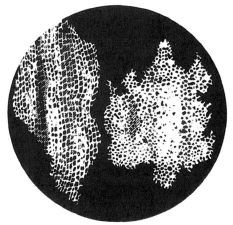The Cell
Why should a chapter regarding the cell begin with the name of Robert Hooke (1635-1703)? Did he discover cells? No. Robert Hooke liked to play with microscopes, and he wrote descriptions of the fly’s compound eye, lice, fungi, and gnats. He was interested in and studied many things, including gravity, the motions of heavenly bodies, the nature of light, clocks, springs, and balances. But he is recalled in the study of botany for introducing the name cell to describe the minute units that are the building blocks of life. In 1665 he was peering through his microscope at a thin slice of cork |
| Figure 2-1 Cork cells as seen by Robert Hooke in 1665. Among his comments was that it “seems to be like a kind of Mushrome.” |
We now define a cell as "a mass of protoplasm surrounded by a membrane and containing a nucleus or a number of nuclei". Thus, there were no cells present in the material examined by Robert Hooke; rather, Hooke observed empty spaces where cells previously resided.




